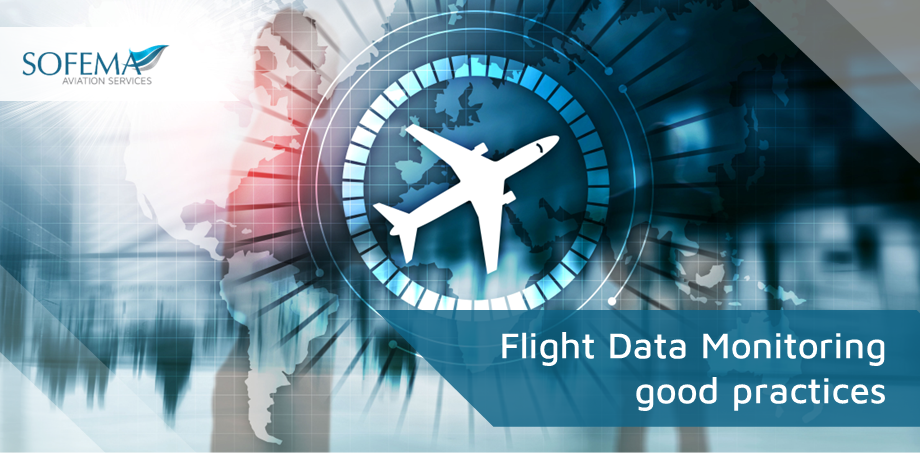Flight Data Monitoring good practices presented by Sofema Aviation Services (SAS)
Introduction – Flight Data Monitoring (FDM)
FDM is considered a proactive and non-punitive use of digital flight data derived from routine ops to improve aviation safety” ((EU) 965/2012). The FDM program is considered a component of the operator’s Safety Management System.
An FDM programme is essentially non-punitive, and should function within a just culture environment to meet the operator’s overall responsibilities related to its Management System.
Primary System Elements of an Effective FDM:
- An effective confidential reporting system.
- FDM is a primary source of Data for monitoring the operational safety level.
- Enables Dissemination of information to training departments and flight crews.
- Enables definition of adequate measures for safety improvement and assurance.
Considering the role of a European National Aviation Authority
- Oversight of the FDM Management System
- Awareness of how the FDM data is used and analyzed by the aircraft operator
- Potential to feed data to the State Safety Programme (SSP) (General Level)
Operators FDM Obligations
The essential elements of the Management System of an aircraft operator are described in ORO.GEN.200. Summary Follows:
- the identification of aviation safety hazards entailed by the activities of the operator,
- their evaluation, and
- the management of associated risks, including taking actions to mitigate the risk and verify their effectiveness;
Just Culture and Gross Negligence Violations
- In cases of gross negligence or a significant continuing safety concern, the decision to sanction an individual flight crew member should be made within the Management System framework in accordance with fully understood and documented procedures.
European Regulation Air Operation Rules
- ORO.AOC.130 of Commission Regulation (EU) 965/2012, Annex III (Part ORO) contains the implementing rule requiring an FDM programme for aeroplanes with an MCTOM of over 27 000 kg and operated for commercial air transport. Commission Regulation (EU) 965/2012 is applicable in all EASA Member States since 29 October 2014.
- AMC1 ORO.AOC.130 of EASA Executive Director (ED) Decision 2012/017/R contains acceptable means of compliance for the implementation of paragraph ORO.AOC.130 of the implementing rules.
- AMC1 ORO.AOC.130 covers the following aspects:
o Use of FDM information
o Flight Data Monitoring Analysis Techniques
o Flight Data Monitoring Analysis, Assessment and Process Control Tools
o Education and Publication
o Accident and incident data requirements
o Company occurrence reporting scheme
o Data recovery strategy
o Data retention strategy
o Data Access and Security policy
o Procedure Documentation
o Airborne systems and equipment
Note – See also GM1 ORO.AOC.130 of EASA ED Decision 2012/017/R for additional guidance information.
Flight Data Monitoring for Alternative Training and Qualification Programmes
o An ATQP allows operators to provide a more effective and more operator-specific recurrent training and checking package for its crews.
o The Programme ensures a higher level of civil aviation safety by utilising improved training and evaluation over the current system.
o The Programme is a company and type specific alternative to traditional training. Ongoing data collection can be developed into a responsive programme that can adapt to an operator’s changing requirements such as new equipment, new technology or a differing route structure. Focusing on specific needs of fleets and groups of pilots, targeted training can enhance performance while reducing costs in the long term.
Note: Operational requirements applicable to an Alternative Training and Qualification Programme are described ORO.FC.A.245.
- An acceptable means of compliance is provided by EASA ED Decision 2012/017/R, AMC1 ORO.FC.A.245 outlining the purpose of FDM for ATQP is to enable the operator to:
o provide data to support the implementation of ATQP and justify changes to the ATQP;
o establish operational and training objectives based upon an analysis of the operational environment;
o monitor the effectiveness of flight crew training and qualification.
o ATQP should include a feedback loop to measure if the overall targets of training are being achieved. (An FDM programme is expected as a basis for such a feedback loop.)
Note: FDM data collection should reach a minimum of 60% for all relevant flights conducted by the operator before ATQP approval is granted.
Advanced FDM Program – AMC1 ORO.FC.A.245, ‘an advanced FDM programme is determined by the level of integration with other safety initiatives implemented by the operator, such as the operator’s Management System.
- The programme should include both systematic evaluations of data from an FDM programme and flight crew training events for the relevant crews.
- Data collection should reach a minimum of 80% of all relevant flights and training conducted by the operator. (This proportion may be varied as determined by the competent authority.’)
Flight Data Recorder (FDR) Serviceability Maintenance and Oversight
- CAT.GEN.MPA.195 requires:
o that the aircraft operator maintains the serviceability of the flight recorders through operational checks. (ref AMC1 CAT.GEN)
o an annual inspection of the FDR recording (relaxed in the case of a company program) subject to certain requirements.
– Source of FDR mandatory flight parameters and of FDM data should be the same,
– FDR fitted with reliable built-in-test equipment,
– The integrity of the FDR mandatory flight parameters should be monitored by the FDM programme. (Means under certain conditions, an FDM programme can be an acceptable substitute for the annual inspection of the FDR recording.
Next Steps
Follow this link to our Library to find & Download related documents for Free.
Sofema Aviation Services & Sofema Online offer Flight Data Monitoring Courses available as Classroom, Webinar or Online Training. For additional information or guidance please email team@sassofia.com
Tags:
aviation, aviation safety, EASA, Safety Management System, SMS, Aviation Safety Management System, Aviation SMS, Just Culture, Flight Data Monitoring, Aviation Risk, SAS blogs, Safety Hazards, EU 965/2012, Flight Data Monitoring (FDM)





